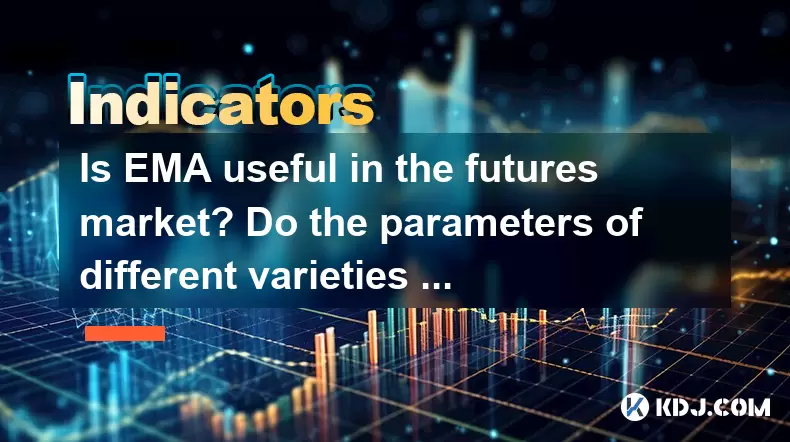-
 bitcoin
bitcoin $122090.672462 USD
1.59% -
 ethereum
ethereum $4493.758974 USD
0.56% -
 xrp
xrp $3.033145 USD
0.65% -
 tether
tether $1.000629 USD
0.00% -
 bnb
bnb $1169.854250 USD
7.07% -
 solana
solana $230.954786 USD
-0.19% -
 usd-coin
usd-coin $0.999785 USD
0.00% -
 dogecoin
dogecoin $0.256108 USD
-1.12% -
 tron
tron $0.342333 USD
-0.12% -
 cardano
cardano $0.859632 USD
-0.10% -
 hyperliquid
hyperliquid $48.932146 USD
-2.25% -
 chainlink
chainlink $22.345466 USD
-1.29% -
 ethena-usde
ethena-usde $1.000217 USD
-0.03% -
 avalanche
avalanche $31.203456 USD
1.93% -
 sui
sui $3.579145 USD
1.05%
Is EMA useful in the futures market? Do the parameters of different varieties need to be adjusted?
EMA is crucial in futures trading, reacting quickly to price changes; adjust parameters for different assets to optimize trend identification and trading signals.
May 21, 2025 at 04:42 pm

Introduction to EMA in Futures Trading
The Exponential Moving Average (EMA) is a widely used technical indicator in the cryptocurrency futures market. Traders rely on EMAs to identify trends and make informed decisions about entering or exiting trades. But the question remains: is EMA truly useful in the futures market, and do the parameters need adjustment for different varieties? Let's delve into the specifics to understand how EMA can be effectively utilized in futures trading.
Understanding EMA and Its Importance
EMA is a type of moving average that places a greater weight and significance on the most recent data points. Unlike the Simple Moving Average (SMA), which assigns equal weight to all values, EMA reacts more quickly to price changes. This makes it particularly useful in the volatile cryptocurrency futures market, where rapid price movements are common.
The formula for calculating EMA is as follows:
[ \text{EMA} = (\text{Price} - \text{Previous EMA}) \times \text{Multiplier} + \text{Previous EMA} ]
Where the Multiplier is calculated as:
[ \text{Multiplier} = \frac{2}{\text{Time period} + 1} ]
Applying EMA in Futures Trading
In the context of futures trading, EMA can be used in several ways. One of the most common applications is to identify trend direction. When the price is above the EMA, it suggests a bullish trend, while a price below the EMA indicates a bearish trend. Traders often use multiple EMAs with different time periods to gain a more comprehensive view of the market.
For instance, a common strategy involves using a short-term EMA (e.g., 9-day EMA) and a long-term EMA (e.g., 21-day EMA). When the short-term EMA crosses above the long-term EMA, it is considered a bullish signal, and vice versa for a bearish signal. This crossover strategy can help traders enter or exit positions at optimal times.
Adjusting EMA Parameters for Different Futures Varieties
While the basic concept of EMA remains the same across different futures varieties, the parameters may need adjustment based on the specific characteristics of the asset being traded. For example, a highly volatile cryptocurrency like Bitcoin might require shorter EMA periods to capture rapid price movements, whereas a more stable asset might benefit from longer periods to filter out noise.
Here are some steps to adjust EMA parameters for different futures varieties:
- Analyze Historical Data: Start by examining the historical price data of the specific futures variety. Look for patterns in volatility and price movements.
- Test Different Periods: Use a backtesting tool to test different EMA periods. For example, you might start with a 10-day EMA and gradually increase or decrease the period to see how it affects the indicator's responsiveness.
- Evaluate Performance: Compare the performance of different EMA settings in terms of signal accuracy and profitability. Choose the period that offers the best balance between responsiveness and reliability.
- Monitor and Adjust: Continuously monitor the market and adjust the EMA parameters as needed. Market conditions can change, and what worked in the past may not be effective in the future.
EMA in Different Trading Strategies
EMA can be integrated into various trading strategies, from simple trend-following to more complex systems involving multiple indicators. Here are a few examples:
- Trend-Following Strategy: Use EMA crossovers to determine entry and exit points. For instance, enter a long position when a short-term EMA crosses above a long-term EMA, and exit when the short-term EMA crosses below the long-term EMA.
- Mean Reversion Strategy: In this approach, traders look for instances where the price deviates significantly from the EMA and then reverts back to it. They might enter a trade when the price is far from the EMA and expect it to return to the average.
- Combining with Other Indicators: EMA can be used in conjunction with other technical indicators like the Relative Strength Index (RSI) or the Moving Average Convergence Divergence (MACD) to confirm signals and increase the probability of successful trades.
Practical Example: Using EMA in Bitcoin Futures Trading
To illustrate the practical application of EMA in futures trading, let's consider a scenario involving Bitcoin futures. Suppose you are trading Bitcoin futures and want to use a 10-day EMA and a 20-day EMA to identify trading opportunities.
- Step 1: Plot the 10-day and 20-day EMAs on your trading chart.
- Step 2: Monitor the chart for crossovers between the two EMAs. When the 10-day EMA crosses above the 20-day EMA, it indicates a potential bullish trend.
- Step 3: Enter a long position when you observe the bullish crossover. Set a stop-loss order below the recent low to manage risk.
- Step 4: Monitor the position and exit when the 10-day EMA crosses below the 20-day EMA, signaling a potential bearish trend.
By following these steps, you can effectively use EMA to make informed trading decisions in the Bitcoin futures market.
Frequently Asked Questions
Q: Can EMA be used for short-term trading in the futures market?A: Yes, EMA is particularly useful for short-term trading due to its sensitivity to recent price changes. Traders often use shorter EMA periods, such as 5-day or 10-day, to capture quick market movements and make timely trading decisions.
Q: How does EMA compare to SMA in the context of futures trading?A: EMA is generally preferred over SMA in futures trading because it reacts more quickly to price changes. This is crucial in the volatile cryptocurrency market, where timely decisions can significantly impact trading outcomes. SMA, on the other hand, is smoother but may lag behind price movements.
Q: Is it necessary to use multiple EMAs for effective futures trading?A: Using multiple EMAs can provide a more comprehensive view of the market and help confirm trading signals. While a single EMA can be useful, combining short-term and long-term EMAs allows traders to identify both short-term fluctuations and long-term trends, enhancing the accuracy of their trading strategies.
Q: Can EMA be used in automated trading systems for futures?A: Yes, EMA can be effectively incorporated into automated trading systems. Many algorithmic traders use EMA crossovers and other EMA-based signals to automate their entry and exit points, allowing for consistent and disciplined trading in the futures market.
Disclaimer:info@kdj.com
The information provided is not trading advice. kdj.com does not assume any responsibility for any investments made based on the information provided in this article. Cryptocurrencies are highly volatile and it is highly recommended that you invest with caution after thorough research!
If you believe that the content used on this website infringes your copyright, please contact us immediately (info@kdj.com) and we will delete it promptly.
- BlockDAG, DOGE, HYPE Sponsorship: Crypto Trends Shaping 2025
- 2025-10-01 00:25:13
- Deutsche Börse and Circle: A StableCoin Adoption Powerhouse in Europe
- 2025-10-01 00:25:13
- BlockDAG's Presale Buzz: Is It the Crypto to Watch in October 2025?
- 2025-10-01 00:30:13
- Bitcoin, Crypto, and IQ: When Genius Meets Digital Gold?
- 2025-10-01 00:30:13
- Stablecoins, American Innovation, and Wallet Tokens: The Next Frontier
- 2025-10-01 00:35:12
- NBU, Coins, and Crypto in Ukraine: A New Yorker's Take
- 2025-10-01 00:45:14
Related knowledge

What is a tower bottom candlestick pattern? Does it have a high success rate?
Sep 22,2025 at 07:18am
Tower Bottom Candlestick Pattern Explained1. The tower bottom candlestick pattern is a reversal formation that typically appears at the end of a downt...

What is a black hole pattern in the MACD indicator? Is it a cause for concern?
Sep 21,2025 at 06:54pm
Bitcoin's Role in Decentralized Finance1. Bitcoin remains the cornerstone of decentralized finance, serving as a benchmark for value and security acro...

How can I use the psychological line (PSY) to determine market sentiment?
Sep 17,2025 at 02:19pm
Understanding the Psychological Line (PSY) in Cryptocurrency TradingThe Psychological Line, commonly referred to as PSY, is a momentum oscillator used...

How can I determine if a double top pattern has officially formed?
Sep 21,2025 at 03:18am
Understanding the Structure of a Double Top Pattern1. A double top pattern consists of two distinct peaks that reach approximately the same price leve...

What is the Golden Valley pattern on the moving average? Is it better than the Silver Valley pattern?
Sep 21,2025 at 02:54pm
Understanding the Golden Valley Pattern in Moving Averages1. The Golden Valley pattern is a technical formation observed in cryptocurrency price chart...

What does a death cross of the RSI in the strong zone (above 50) mean?
Sep 17,2025 at 10:54pm
Understanding the Death Cross in RSI Context1. The term 'death cross' is traditionally associated with moving averages, where a short-term average cro...

What is a tower bottom candlestick pattern? Does it have a high success rate?
Sep 22,2025 at 07:18am
Tower Bottom Candlestick Pattern Explained1. The tower bottom candlestick pattern is a reversal formation that typically appears at the end of a downt...

What is a black hole pattern in the MACD indicator? Is it a cause for concern?
Sep 21,2025 at 06:54pm
Bitcoin's Role in Decentralized Finance1. Bitcoin remains the cornerstone of decentralized finance, serving as a benchmark for value and security acro...

How can I use the psychological line (PSY) to determine market sentiment?
Sep 17,2025 at 02:19pm
Understanding the Psychological Line (PSY) in Cryptocurrency TradingThe Psychological Line, commonly referred to as PSY, is a momentum oscillator used...

How can I determine if a double top pattern has officially formed?
Sep 21,2025 at 03:18am
Understanding the Structure of a Double Top Pattern1. A double top pattern consists of two distinct peaks that reach approximately the same price leve...

What is the Golden Valley pattern on the moving average? Is it better than the Silver Valley pattern?
Sep 21,2025 at 02:54pm
Understanding the Golden Valley Pattern in Moving Averages1. The Golden Valley pattern is a technical formation observed in cryptocurrency price chart...

What does a death cross of the RSI in the strong zone (above 50) mean?
Sep 17,2025 at 10:54pm
Understanding the Death Cross in RSI Context1. The term 'death cross' is traditionally associated with moving averages, where a short-term average cro...
See all articles










































































